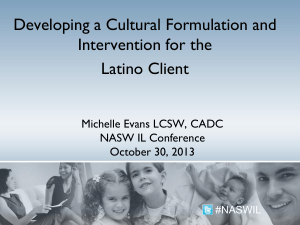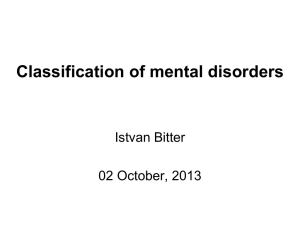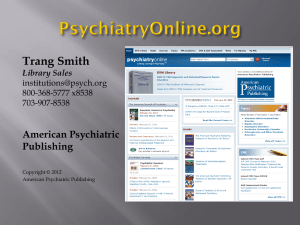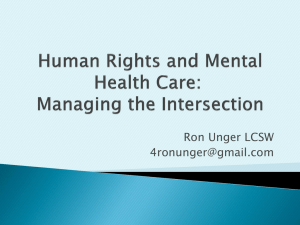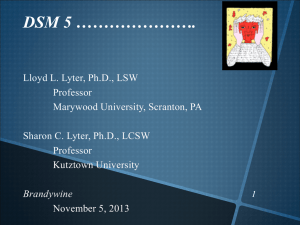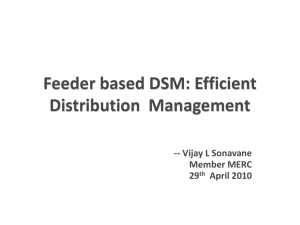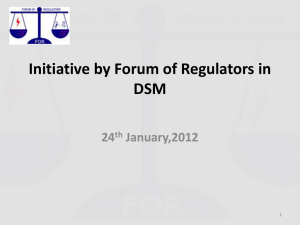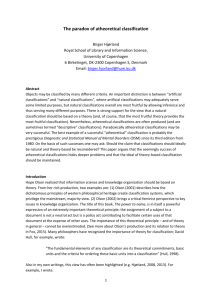Issues of Culture in Psychiatric Assessment and Treatment
advertisement
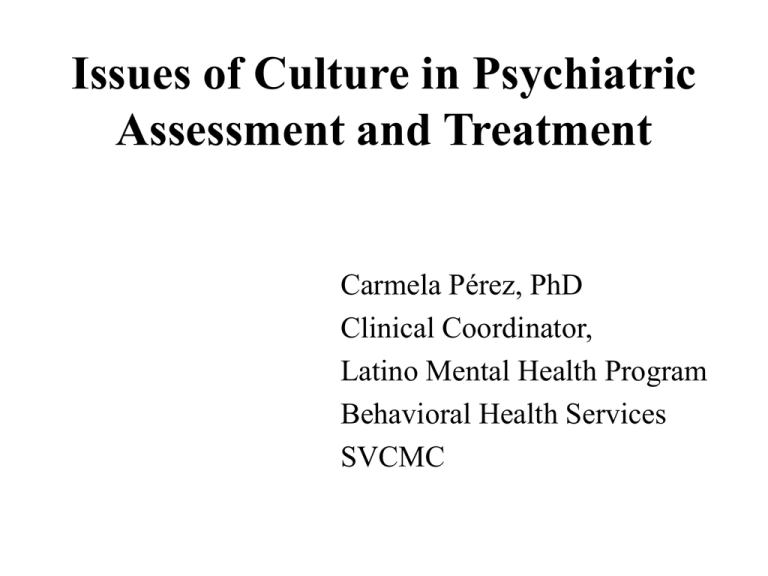
Issues of Culture in Psychiatric Assessment and Treatment Carmela Pérez, PhD Clinical Coordinator, Latino Mental Health Program Behavioral Health Services SVCMC Importance • Being culturally competent improves the care we provide to all patients. • There is overwhelming evidence of the underutilization of mental health services by “minority” cultural groups. • “Minority” groups are becoming majority- e.g. Latinos as fastest growing ethnic minority in US. Estimated that by 2050 Latinos will comprise 25% of US population Latino Underutilization and Views Towards Mental Health • Research consistently finds that Latinos underutilize mental health services • Specifically, findings suggest close to 40% lower probability of using outpatient/ambulatory psychiatric services as compared to Euro-Americans • Conversely, Latinos have been found not only overrepresented on inpatient wards as compared to EuroAmericans, but also admitted for longer periods of time (Latinos= 5days; Euro-Americans= 3 days) Objectives • To better understand culturally competent psychiatric care • To learn about using a cultural formulation in psychiatric assessment • To be aware of the impact of culture in the psychiatric treatment -- e.g. Latinos What is Cultural Competence? (American Academy of Family Physicians, 2000) • A set of congruent behaviors, atttitudes and policies that come together as a system, agency or among professionals and enable that system, agency, or those professionals to work effectively in cross-cultural situations. • The word “culture” is used because it implies the integrated pattern of human thoughts, communications, actions, customs, beliefs, values and institutions of a racial, ethnic, religious, or social group. • The word competence is used because it implies having a capacity to function effectively. Cultural Competence • 2 Approaches – Can occur in the context of being able to work with various cultures; – and/or with one specific cultural group Challenges to Cultural Competency • Recognition of clinical differences among people of different ethnic and racial groups • Communication-- verbal, body language • Ethics-- Respect for belief systems of others and effects of these belief systems on well-being • Trust-- Many patients wary of authority figures and the care we provide for good reasons • Realization that we do not have all the answers Levels of Cultural Competence • Systems level (Government, Policy)Includes guidelines for delivery of service; hiring staff; access to care • Agency level (Hospital, Community Services)- Developing programs for ethnically diverse patients • Individual therapist level- What we do as individual treaters The Culturally Competent Therapist • Being a Good General Therapist- Asking extra questions about culture • Dynamic Sizing- Knowing when to individualize and when to generalize (distinguishing whether cultural issues play a role in the patient’s problems or not) • Ethnic Specific Knowledge/UnderstandingUtilizing culturally appropriate skills and attitudes in treatment Problems in Cross-Cultural Diagnosis • Missing the diagnosis entirely • Underdiagnosis/ Overdiagnosis -Inaccurate assessment of the severity of a disorder • Mistaken diagnosis Psychiatric Assessment Across Cultural Boundaries • The Clinical Interview • Mental Status Examination • Cultural Formulation-- DSM IV The Clinical Interview • Establishing trust and open communication • Facilitation-- Allowing (letting the patient warm up), and guiding the patient to report signs, symptoms, and perceived problems (Remember many ethnic minority patients report somatic symptoms as presenting problem) • Clarification-- Crucial for orienting the therapist to the nature of the problem and its psychosociocultural context. (May need to use a Cultural Broker or Translator- friend or relative of the patient who can help to clarify whether the patient’s ideas, behaviors, and emotional responses are culturally congruent, idiosyncratic, bizarre, etc.) Mental Status Examination • Appearance and behavior-- Errors in observation may originate because the observer is unfamiliar with normal vs abnormal appearances in a particular culture • Remember Fund of Information greatly determined by level of education and SES • Careful with importance attributed to proverbs, which also do not translate across cultures Cultural Formulation-- DSM IV • Supplements DSM IV multiaxial diagnoses • Provides a systematic review of the individual’s cultural background, the role of the cultural context in the expression and evaluation of symptoms and dysfunction, and the effect that cultural differences may have on the relationship between the individual and the therapist Cultural Formulation-- DSM IV • Cultural identity of the individual • Cultural explanations of the individual’s illness • Cultural factors related to psychosocial environment and levels of functioning • Cultural elements of the relationship between the individual and the clinician • Overall cultural assessment and diagnosis and care Cultural Formulation-- DSM IV • Cultural identity of the individual – Individual’s ethnic or cultural reference groups – Language abilities, use, and preference (including multilingualism) – For immigrants and ethnic minorities, note separately the degree of involvement with both the culture of origin and the host culture (Phase of Cultural Transition they are at) The Phases of Cultural Transition • Immediate Phase or Arrival – Exitement and euphoria – Disorganization • • • • Suspiciousness, Distrust, and Paranoid Tendencies Lack of differentiation of nonself from self Depression and anxiety Psychosomatic symptoms • Integration-Disintegration • The Therapist as Cultural Intermediary Cultural Formulation-- DSM IV • Cultural explanations of the individual’s illness – Predominant idioms of distress through which symptoms or the need for social support are communicated (e.g., “nervios”, possessing spirits, somatic complaints, inexplicable misfortune, God’s way) – The meaning and perceived severity of the individual’s symptoms in relation to norms of the cultural reference group, and any local illness category used by the individual’s family and community to identify the condition) – The perceived causes or explanatory models that the individual and the reference group use to explain the illness, and the current preferences for and past experiences with professional and popular sources of care Cultural Formulation-- DSM IV • Cultural factors related to psychosocial environment and levels of functioning – Cultural-relevant interpretations of social stressors; available social supports – Levels of functioning and disability – Includes stresses in the local social environment, and the role of religion and kin networks in providing emotional, instrumental, and informational support Cultural Formulation-- DSM IV • Cultural elements of the relationship between the individual and the clinician – Differences in culture and social status between the individual and the clinician – Problems that these differences may cause in diagnosis and treatment (e.g. difficulties in eliciting symptoms or understanding their cultural significance, in negotiating an appropriate relationship or level of intimacy, in determining whether a behavior is normative or pathological) Cultural Formulation-- DSM IV • Overall cultural assessment and diagnosis and care – The formulation concludes with a discussion of how these cultural considerations specifically influence comprehensive diagnoses and care Approaches to the Treatment of Ethnic Minorities • 2 Approaches generally used: – Knowledge about a particular culture gained in the absence of direct experience with patient-- Runs risk of being highly intellectualized, often stereotyped information that has been found not to translate into therapeutic action – Technique-oriented approaches-- Making specific changes in technique based on needs and values of a specific cultural group (e.g. Achieving credibility early in treatment (1st session)) Achieving Credibility with the Ethnic Minority Patient • Patients have expectations and ideas about treatment and our role • Importance to be able to achieve credibility- meet the patient where they are • Ethnic-minority patients have been found to underutilize, and terminate prematurely from, mental health services Major areas for Achieving Credibility • Conceptualization of problem • Means for problem resolution • Goals for treatment Achieving Credibility- Goals for the 1st session • • • • • • • • • Anxiety reduction Relief from distress Cognitive clarity Normalization Reassurance Hope, faith Skills acquisition Coping perspective Goal-setting Latino Values, Interpersonal Relationships and Coping Mechanisms, and Alternative Support Systems and their Impact on Psychiatric Treatment La Familia Latina: Close and Extended Kin • FAMILISMO-- Connectedness • Collective sense of self • The treater as part of the “FAMILIA” Etiology of Psychiatric Illness: Stigma • Mind & Body Connection: llness as having roots in physical imbalance • Illness caused by social indiscretion • Illness as manifestation of one’s standing with God • Illness attributed to evil or magical forces Interpersonal Relationships and Coping Mechanisms • RESPETO and PERSONALISMO • INDIRECTAS Y DICHOS--”Indirect communication” • AGRADECIMIENTO, CONFIANZA, Y SIMPATIA • Coping Mechanisms – – – – FATALISMO CONTROLARSE AGUANTARSE SOBREPONERSE Alternative Support Systems • • • • Alternative Resource Theory BOTANICAS ESPIRITISMO SANTERIA Impact on Delivery of Psychiatric Services • As a result, the Latino patient has a complex set of therapeutic expectations that involve: psychological, emotional, physical (medications), and environmental interventions • The stigma of “El Loco”: Latino patients are reluctant to seek psychiatric services for any mental health problem because of generalization with “Locura” • Expect intermittent treatment- it should not be a surprise to us that psychotherapy, especially in the early phases of treatment, is not a priority particularly since it is not highly valued by Latinos

